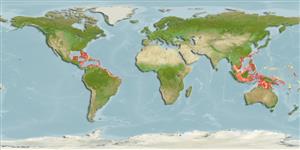Lớp phụ (Subclass) cá vây tia >
Elopiformes (Tarpons and tenpounders) >
Elopidae (Tenpounders)
Etymology: Elops: Greek, ellops = a kind of serpent (Ref. 45335). More on author: Linnaeus.
Môi trường / Khí hậu / Phạm vi
Sinh thái học
; Biển; Thuộc về nước lợ Cùng sống ở rạn san hô; pH range: 0.2 - ?; sống cả ở nước ngọt và nuớc mặn (Ref. 51243); Mức độ sâu 0 - 50 m (Ref. 13325). Subtropical, preferred 27°C (Ref. 107945); 29°N - 17°S
Western Atlantic: Cape Cod (USA), Bermuda, and northern Gulf of Mexico to southern Brazil. Questionable occurrence records in the China (Ref. 52360), Taiwan (47843), and Vietnam (Ref. 9706, 46452).
Bộ gần gũi / Khối lượng (Trọng lượng) / Age
Maturity: Lm ? range ? - ? cm
Max length : 100.0 cm TL con đực/không giới tính; (Ref. 26340); common length : 60.0 cm TL con đực/không giới tính; (Ref. 3718); Khối lượng cực đại được công bố: 10.1 kg (Ref. 4699)
Các tia vây lưng cứng (tổng cộng): 0; Các vây lưng mềm (tổng cộng): 25-29; Tia cứng vây hậu môn 0; Tia mềm vây hậu môn: 16 - 19; Động vật có xương sống: 73 - 85. Scales small, more than 100 in lateral line. Gular plate narrow (Ref. 26938). Silvery overall, with bluish on upper surface (Ref. 7251). Branchiostegal rays: 26-33 (Ref. 4639).
Occur in shallow neritic areas, over muddy bottoms (Ref. 5217). Also found in brackish estuaries and juveniles are common in lagoons and hyper-saline bays (Ref. 5217). Form large schools close to the shore (Ref. 9987). Feed mainly on crustaceans and small fishes. Spawn in the open sea (Ref. 5217). Larval development is represented by profound changes in body form accompanied by 2 periods of length increase, interspaced by a period of length decrease (Ref. 4639). Noted for their habit of skipping along the surface of the water and for jumping after being hooked (Ref. 5521). Marketed fresh, salted and frozen but considered a second rate food fish (Ref. 3718). Rhynchobothrium bulbifer found in the viscera of the adult (Ref. 37032).
Spawns offshore, the larvae drifting towards the coast where they shelter and grow (Ref. 9987). Leptocephalus larvae are found in salinities as low as 0.0+ to 0.8 ppt (Ref. 75142).
Robins, C.R. and G.C. Ray, 1986. A field guide to Atlantic coast fishes of North America. Houghton Mifflin Company, Boston, U.S.A. 354 p. (Ref. 7251)
IUCN Red List Status (Ref. 115185)
CITES (Ref. 94142)
Not Evaluated
Threat to humans
Harmless
Human uses
Các nghề cá: buôn bán nhỏ; cá để chơi: đúng; mồi: usually
Các công cụ
Special reports
Download XML
Các nguồn internet
